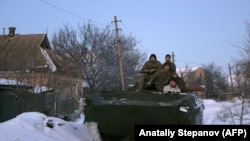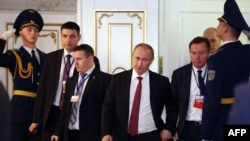On January 23, the Russian Defense Ministry’s official media outlet TV Zvezda reported that the Organization for Security and Cooperation and Co-operation in Europe (OSCE) Special Monitoring Mission in Ukraine’s embattled Donbas region spotted Ukrainian armored vehicles in the area. Specifically, it mentioned three types of armored vehicles -- a ZU-23 anti-aircraft gun, a BTR-70 armored personnel carrier, and a BRDM-2 patrol vehicle.
A review of the OSCE SMM’s spot reports from January 22-23 appears to confirm this claim, although only the ZU-23 and BRDM-2 are mentioned, not the BTR-70.
This article fits the general tenor of Russian state media coverage of Ukrainian military activity, which regularly accuses the Ukrainian side of violating the Minsk peace agreement and/or preparing to launch offensive operations.TV Zvezda pointed to allegedly serious incidents, citing as sources Russian-controlled or dominated authorities in the region. For example, on January 18 and January 22, TV Zvezda ran two stories claiming that Ukrainian forces fired on the Russian-led “militia” using tanks. Both stories cite the authorities of the self-proclaimed Donetsk and Luhansk People’s Republics rather than the OSCE.
It should be noted, that the armored vehicles in question belong to the Ukrainian Armed Forces and were on Ukrainian territory. More importantly, it appears none of the vehicles cited by TV Zvezda -- including the BTR-70, which isn’t mentioned in the actual OSCE SMM report -- violate the Minsk agreement.
The Minsk agreement governs military movements in the area. The second point in the February 2015 agreement required “withdrawal of heavy weapons” by both Ukrainian and Russian-backed forces, citing specifically “the artillery systems of caliber of 100 and more, a security zone of 70km wide for MLRS and 140km wide for MLRS Tornado-S, Uragan, Smerch and Tactical Missile Systems (Tochka, Tochka U).”
The ZU-23 anti-aircraft gun system, which may have been mounted on an MT-LB armored personnel carrier, consists of twin 23mm cannons. While the weapon system is no longer very effective against modern military aircraft, armies and insurgent groups around the world have often used it in ground combat. Here is a video of the weapon being fired by Ukrainian forces from a ground position.
Ukraine’s military has also mounted the weapon on the Soviet-era MT-LB armored personnel carrier. This configuration is known as the MT-LB-T-23-2.
The BTR-70 is a wheeled armored personnel carrier that the Soviet army began using in the 1970s. It is armed only with a 14.5mm KPV heavy machine gun and a 7.62mm PKT general purpose machine gun.
The BRDM-2 is an armored scout car that carries the same armament as the BTR-70, but it is much smaller.
The Minsk agreement does not ban any of the vehicles cited by TV Zvezda from being located near the line of contact. In addition, these vehicles would not be indicative that a major offensive operation is afoot.
Perhaps more importantly, the TV Zvezda story leaves out information from the same OSCE report concerning Russian military equipment located in Donbas territory not controlled by Kyiv.
For example, the OSCE mission reported on January 23 that two 2S1 Gvozdika 122mm self-propelled howitzers and four towed D-30 Lyagushka 122mm howitzers were located near Bile, 22km west of Luhansk. Based on the caliber and distance from the line of contact, the presence of those could possibly violate the Minsk agreement.
In truth, both sides of the Ukraine conflict have been accused of violating this aspect of the Minsk agreement. However, the Ukrainian government claims higher moral ground. Because Russian personnel and military invaded Ukraine, so-called separatist leaders both military and political were Russian citizens and Russian Army veteran Igor “Skelkov” Girkin claimed responsibility for launching the conflict, the Ukrainian government argues the Donetsk and Luhansk areas are “occupied” territory. The U.S. State Department calls the areas “controlled” by Russia.






